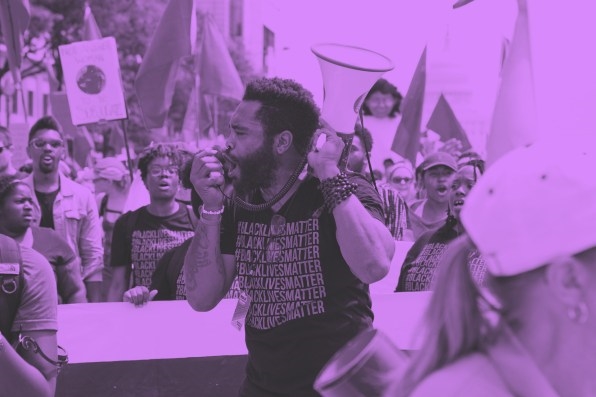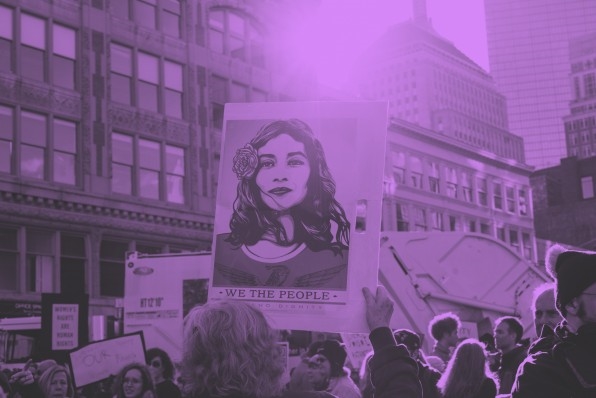Can The Year’s Activist Spirit Continue To Grow In 2018?
Almost overnight, after Donald Trump was elected President of the United States on November 8, 2016, the internet transformed into a hub of action. On the left, desperation abounded, but questions of “How can we push back?” and “How can I get involved?” soon drowned out the despair.
In the short months between the election and Trump’s inauguration, organizers set up the Women’s March, which, when it unfolded on January 22 with approximately 4 million Americans taking to the streets in cities across the country, would prove to be one of the largest demonstrations in U.S history.
The actions didn’t stop there. The March for Science in April saw a global turnout of over 1 million and broke down the historic barrier between science and politics as researchers and scientists united against the administration’s insistence that climate change is not real. Thousands of Americans turned out to protest Trump’s travel ban against people from Muslim-majority countries; they turned out to oppose the administration’s efforts to repeal Obama’s Affordable Care Act; they’re in the midst of turning out to protest the Republican Party’s tax plan, which will gut the middle class to afford a tax cut to corporations and the wealthiest slice of the population.
The question you might be asking right now is: When will the fuse run out? The organizers behind all of these actions—and many more—will tell you: It can’t, and it won’t. Fast Company spoke to a handful of them about what they have planned for the year to come, and how the country can keep its activist spirit alive in 2018.

Resisting With Diversity
Opposition to the Trump administration has been vast and varied, but what has sustained it, and continues to sustain it, is that there is a way into it for every person who feels that their rights or existence has been threatened–and even for people, like well-off white men, who do not, but who object to the administration out of a greater sense of moral-ethical obligation. “This has forced a reckoning of people figuring out new ways to work together,” says Rashad Robinson, executive director of the nonprofit civil rights advocacy organization Color of Change.
From Robinson’s perspective, the act of resisting the current political climate–and the fact of being on the receiving end of an administration’s harshest policies–is not new. “Part of this is recognizing that black people have always resisted,” Robinson says. “And the progressive movement for the past 60 years has really benefited from our participation, particularly that of black women. They have really been the cornerstone of progressive change–when they participate in large numbers, the country has moved in the right direction,” Robinson says. (Witness, for instance, the driving force of black women voters in the election of Doug Jones over Roy Moore for the Alabama Senate.)
With what’s been happening in the country over the past year, though, “we like to think of this not as resisting, but as opposing,” Robinson adds. “How can we not only stop the destructive efforts of the administration but build something better?”

Building A Coalition
While the term “The Resistance” might have gone from rallying cry to online punchline over the course of the year, the people on the ground leading these activist movements have continued their work building coalitions and strengthening the networks that connect them and allow them to work together.
The Women’s March, for instance, was focused on “building a coalition of women of all different backgrounds,” says Vanessa Wruble, the cofounder of March On, a nonprofit advocacy organization that spun off from the original Women’s March group. Wruble, who also helped organize the March itself, tells Fast Company that she was very cognizant “of the tensions that would be exacerbated by a bunch of white women going and marching on Washington without thinking of inclusivity.” After all, 53% of white, female voters in the U.S. voted for Trump. Minority women–particularly lower-income women and immigrants–face the greatest risk under his administration, which has done its level best to roll back affordable healthcare access and threaten immigrants seeking help with deportation.
March On, Wruble says, has been determined to advance the goals of that diverse coalition while remaining responsive to its various needs. The way both the Women’s March and March On have managed this, Wruble says, has been through its structure, which is more decentralized than it seems. None of the 600 Women’s Marches that took place nationally were organized by the same group of women, Wruble says, and March On is powered by a handful of more localized subgroups–a format that March for Science, another nonprofit organization that grew out of a day of advocacy, has also adopted.
Online platforms like The Action Network have allowed subgroups under March On and March for Science to keep in touch at a national level, and to open-source resources like petitions and strategies. But the digital network has also allowed the organizations to grow and mobilize from the ground up. To that end, March On, in the next year, will begin formulating its official agenda, but turning to crowdsourcing to make it happen. “We’re hoping that hundreds of thousands, if not millions, of people will take the poll that we create and let us know what their values are, what they stand for, and what future they want to create for our children, so we can really re-engage the millions who marched and reaffirm the fact that we want their voices to be heard,” Wruble says.

Activating The Base
Finding ways to amplify people’s voices has been key to the work of the Resistance; perhaps no other year has been so filled with reminders from every corner of the internet to call elected officials in the leadup to a significant vote, from the myriad failed attempts to repeal the Affordable Care Act, to the Republican tax plan that looks disturbingly close to becoming law. The Indivisible Guide, which grew from a Google doc compiled by a few former Congressional staffers after the 2016 election to a fully fledged nonprofit organization in the span of a year, has provided constituents with structured dialogue formats that they can follow when on the phone with their elected officials. “As former Congressional staffers, we saw it as our responsibility to show people how they could make a difference,” says Sarah Dohl, chief communications officer for Indivisible.
While Indivisible doesn’t track the total number of calls made to members of Congress, more than 5 million people viewed the guide in the past year, and the organization’s 6,000 sub-groups have collectively held over 500,000 actions, from sit-ins to district office visits. During the Alabama election, it saw people use Indivisible’s peer-to-peer texting tool to send over 242,000 text messages. Republican senators like Mississippi’s Thad Cochran reported being “overwhelmed” by the number of calls asking them to oppose Obamacare repeal efforts.
But organizations like Indivisible are not working alone; Dohl emphasizes that they’re just one branch in a network of grassroots organizations working to boost on-the-ground engagement. The Town Hall Project–an organization that, similar to Indivisible, grew out of a post-election Google Doc–catalogs all elected official town hall meetings happening across the country in an effort to get more constituents out and engaging directly with the democratic process.
And beyond direct political actions like calling representatives and showing up to meetings, “people really want to apply their skills to good use,” says Jessica Alter, one of the cofounders of Tech for Campaigns–a nonprofit organization set up (yes, initially as a Google Doc) to connect progressive campaigns–mostly down-ballot state legislature races–with pro-bono assistance from tech professionals. In just the 11 months it’s been around, Tech for Campaigns has amassed a volunteer network of around 4,000 designers, coders, engineers, and social strategists, all of whom work in tech and want to dedicate their out-of-office time to helping with everything from website design to texting campaigns. TFC’s impact was most palpable in Virginia’s statewide election in November, where volunteers assisted on 12 state legislature campaigns–nine of which won their seats, and two of which went to recounts–and helped fuel the first significant win for the Democrats since 2008. TFC’s work, among other grassroots organizing efforts, also saw 15 Democratic Socialists of America members elected, proving that the enthusiasm for socialism spreading through the country’s younger population is finding a voice in the political landscape. Even though these were small races, Alter says, they’re significant. “Especially at the state legislature level, races are won or lost by a couple hundred votes,” Alter says. “If you, as a volunteer, can help put your skills to work to create a texting or social campaign that will reach thousands of people, you’ll really make an impact.”

Looking Toward Next Year
Next year’s midterms are at the center of many of these group’s efforts for the new year. Tech for Campaigns, Alter says, will continue to funnel the skills of its volunteer base toward smaller campaigns in an effort to build a progressive movement from the ground up. “They’re smaller races, but these politicians decide on major things,” Alter says. “It feels sexier to work on a Senate race or a presidential campaign, but these smaller races are so consequential and often ignored,” she adds. By the end of 2018, TFC wants to undertake 500 campaign projects.
On top of that, Color of Change, Robinson says, is focusing its energy on holding responsible the people and organizations that enable the current administration, whether that be politicians, the media, or even the organization’s allies. Over the past year, that effort coalesced into Color of Change’s successful campaigns to lobby business leaders to quit Trump’s councils, and to push credit card companies that have been processing the funds of white supremacist groups like Stormfront to cut off their services to hate groups. “We need to focus on all these people around Trump, who if they defect or desert him, will diminish his power,” Robinson says. As the 2018 midterms approach, Color of Change will continue to push businesses and companies to divest from racist candidates and organizations, and also, Robinson says, work to change the narrative at the cultural level around race in America. A recent Color of Change report found that, for example, just one popular crime show currently on TV had more than one black writer. “Those shows that depict crime in urban areas, or the stories of black people, often don’t have people of color shaping the stories. We’ve got to change not just the written rules, but the unwritten rules and norms of culture,” Robinson says.
But we also, Robinson says, “have to bring more people into the fight for justice.” And that’s where the work of organizations like March On will also come in in 2018. Launching early next year, March On’s comprehensive strategy, March on the Polls, will mobilize its members to get ready to, quite literally, get out and march people to the polls on Election Day. “It’s the idea that in every town, every city, every precinct, we can get people to march together, en masse, to their polls,” Wruble says. She’s envisioning a hyperlocal, but also national effort that will, in many ways, make visible the work and the coalition-building the Resistance has done. But of course, Wruble says, getting to the point where that kind of organized effort will be possible will require much more work. “We need to be focused on registering people to vote, fighting voter suppression, convincing people that their vote matters, and educating people about who and what they’re voting for,” Wruble says. For that, we’ll need all the tools the Resistance has been building since it began.
Fast Company , Read Full Story
(29)










